We're staying in Central Vietnam but moving south from Hue to Hoi An. It's a comfortable drive of about 160 km — comfortable, that is, if you have an experienced local driver! Which we did. (Word of advice: NEVER drive yourself in Vietnam. Traffic is terrifying.) Our route takes us through Da Nang, which is the biggest city in this region, and it's where the regional airport is located.
We're travelling through a region where there was heavy fighting in the American war. The country was divided into North and South Vietnam at the 17th parallel, so this region was close to the border with North Vietnam. This was contended country. If you've seen the movies Full Metal Jacket and Platoon, they show the fighting in Da Nang and Hue.

We leave Hue on a rainy, grey day and pass through Lap An Lagoon, which is a brackish lagoon and famous beauty spot. Local farmers grow oysters and pearls in the lagoon. I did have an excellent egg coffee here but the weather meant we missed out on seeing the lagoon in its full splendour surrounded by mountains. Next time!
The Hai Van Pass is a winding road that (apparently!) provides good views in good weather. If you peer into the distance in the centre of the next photo, you can see the tall buildings of Da Nang in the distance. Da Nang is booming with development. I doubt there's a spare spot of land on the beach that isn't being built on.

Before we reach Hoi An, we set out to conquer one of the Marble Mountains. This mountainous region is famous for (surprise!) the high-quality marble that has been used for centuries.
The Marble Mountains are a group of five limestone peaks, or karsts (as in Ha Long Bay). The five karsts are named after the five elements: metal, water, wood, fire and earth. Ancient people considered these sites sacred, and over time pagodas and shrines were built, as well as a lot of very uneven steps! On Water Mountain, which is the tourist mountain, there is an elevator that can be used to go up the mountain (at the cost of one dollar). Yes, we all used it, but we did walk down the mountain when we were finished. And while we were navigating the trails on the mountain, there were hundreds of steps to climb!
Being limestone, the mountain is riddled with caves. Many of these have been turned into shrines. I think the mark of the devotee is being able to climb hundreds of steps. On a scale of 0 to 10, these shrines get 10 for atmosphere, zero for accessibility.
We emerged from the subterranean shrines, were revived by some fresh coconut water (out of coconuts) and enjoyed our stroll downhill. Humidity felt like it was about 95%, temperature about 35 °C. A nice balmy day in central Vietnam!
You may have noticed the large number of marble statues that dot the landscape. We visited a local marble-statue-making enterprise ... for those enormous purchases. The store guides assured us that they could ship any statue anywhere in the world. In fact, we saw a large number of pallets being prepared for New Delhi, India. One of us (not me) was super-tempted to order a large Happy Buddha for her garden ... but no, we resisted.
And finally on to Hoi An. We stayed at a resort on Cua Dai beach, about 10 minutes from Hoi An. Cua Dai saw a lot of fighting during the American War, but it was also the favourite beach for GIs who scored some R&R.
Sadly for us, it wasn't ideal beach weather. Next time! (I know, I've said that before.)
The old city of Hoi An is a charming, bustling little town near the mouth of the Thu Bon River. Hoi An was a trading port that thrived between the 15th to 19th centuries; it traded with countries of Southeast and East Asia and with the rest of the world. It was particularly well known for trading ceramics to China, India, Japan and Europe — and even to Egypt. It wasn't called Hoi An back then. It was called Faifo (or Faifoo).
The river port silted up in the late 1800s and it declined as a trading port, but this 'problem' turned out to be a blessing. For modern tourists, anyway. Hoi An stayed in a little bubble. It's now an example of a traditional city that has not been spoiled by modern development.
It's also a UNESCO World Heritage Site.
The town of Hoi An reflects the contact it had with trading partners — the buildings are a mix of Vietnamese, Chinese, Japanese and European styles. It was developed as a grid of streets with one axis parallel to the river. In its life as a trading port, customers walked into the shops from the street, while behind the shop, the river made it easy for goods to be transported.
It's a pretty, pretty town.
It's also the town famous for its tailors! Every tourist has some item of clothing made for them in Hoi An. Okay, maybe not every tourist, but very close. Of our party of six, two of us had something made, and one of us bought quite a lot of fabric. That's close enough to 'every', isn't it?
The Japanese bridge with a pagoda on top, built around the 1600s, is a famous sight (site?) in Hoi An. I found it interesting that Hoi An was brought back from the brink of neglect and decrepitude in the 1990s by a Polish architect and conservator. There is a statue of him in the city, and apparently there is a strong relationship between Poland and Vietnam. Perhaps because both are countries that have been harried and harrassed by powerful neighbours over the centuries, and both have been devastated by wars that they did not instigate? (Both also have delicious dumplings, but that's probably not the basis for an international relation cordiale.)

There's so much to see, so much life around the city, so many photographic moments. Including Suz posing as a vegetable seller, with the real veggie lady (wearing Christian Dior shorts, a lovely touch) insisting that we pay her for the 'loan' of her veggie baskets and hat. The woman is in the yellow top was another tourist who couldn't wait to try carrying the baskets herself.
The local boat owners are keen to offer tourists a trip up or down the river. The boat trip didn't seem very popular during the day ...
... but at night the boat trips are in great demand. After dark, Hoi An bursts into glorious colour with all the lanterns lit around the river and the old town.
It's a transformation. The bridge across the river looks fairly dull during the day, but transforms into dazzling colours by night. From this, to this!
Like everywhere we'd been in Vietnam, the food was wonderful. Including the street food! We were the first customers of the evening for a young street food vendor. The best banana pancakes you can imagine, hot off the crepe-cooker.
Tailoring completed — ordered at 10 am, my sundress was ready at 5 pm!
We enjoyed our two days and two nights in Hoi An immensely. It's not hard to see why 4 million tourists (3 million of them from other countries) visit Hoi An each year. We'll be back. But now it was time to move further south, to Ho Chi Minh city, so we said cheerio to Luke as he headed up north.














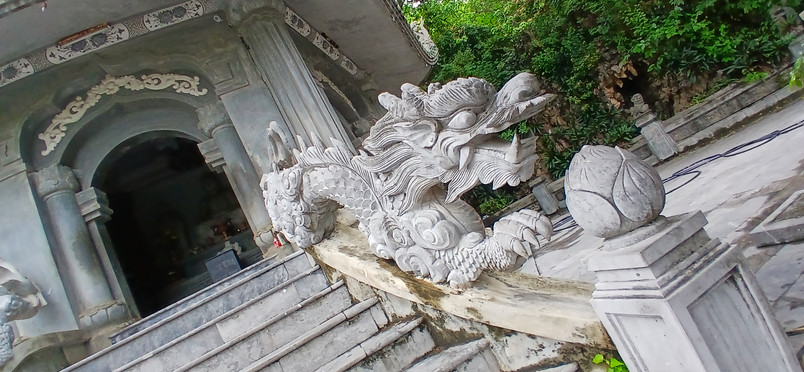











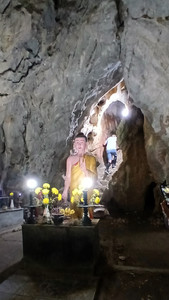





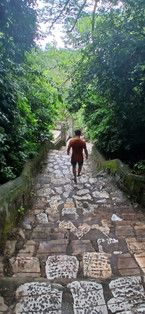



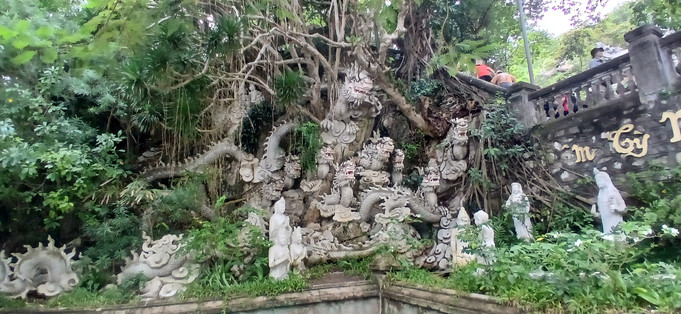

































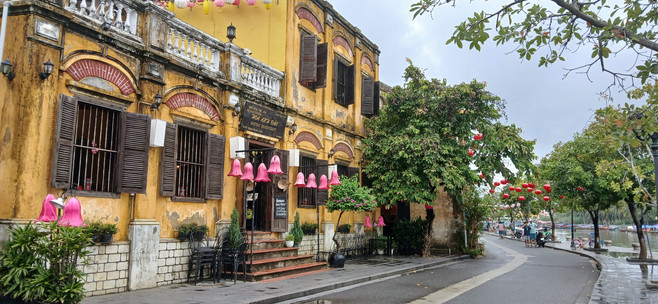







































Comments